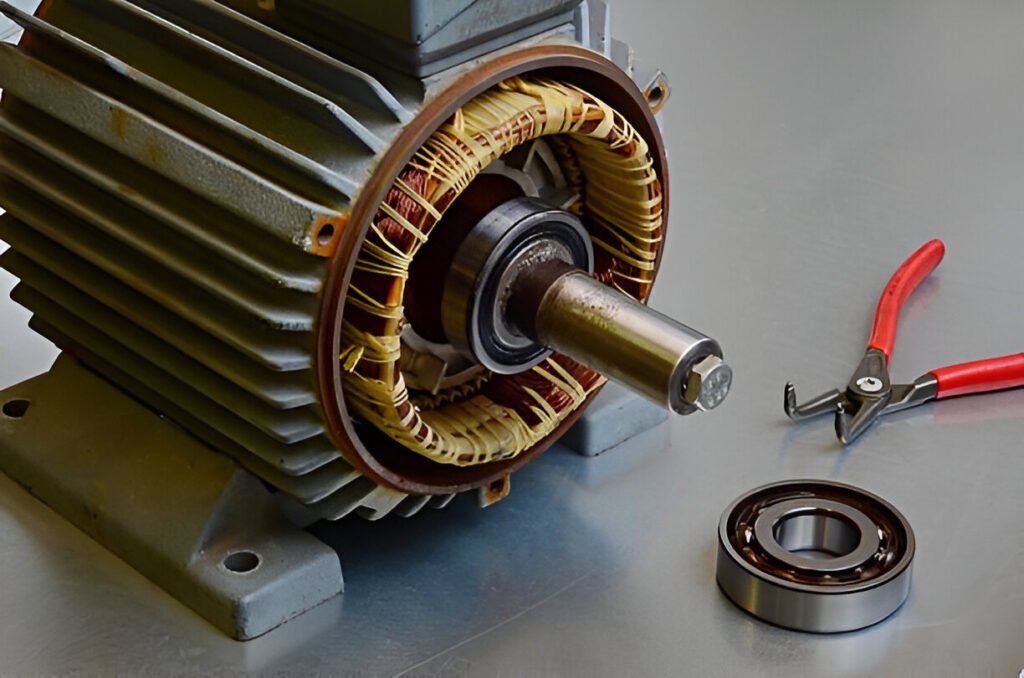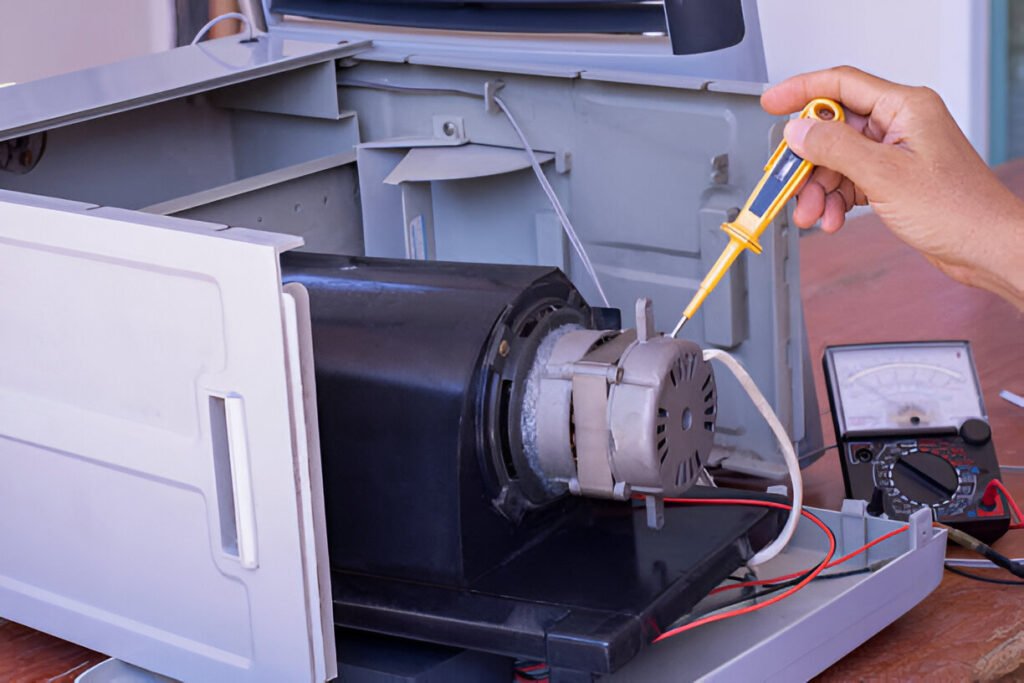Ball Bearing Vs Sleeve Bearing: What Is the Difference
Discover the key differences between ball bearing and sleeve bearing fans to make an informed choice for your application.
Read More
Electric motor efficiency is a crucial factor in determining the performance and energy consumption of electric motors. Understanding how to calculate, measure, and improve motor efficiency can help you make informed decisions when selecting or optimizing motors for your applications.
This comprehensive guide will cover the fundamentals of electric motor efficiency, including formulas for calculating efficiency and power, factors influencing efficiency, and methods for measuring efficiency. We’ll also discuss how to convert horsepower to kilowatt-hours and calculate full-load amperage (FLA) for single-phase and three-phase motors.
Electric motor efficiency refers to the ratio of mechanical output power to electrical input power, expressed as a percentage. In other words, it measures how effectively an electric motor converts electrical energy into mechanical energy. A higher efficiency indicates that more of the input power is being converted into useful work, while a lower efficiency suggests that more energy is being lost as heat or other forms of waste.
Efficiency (%) = (Output Power ÷ Input Power) × 100
To use this formula, first determine the motor’s output power and input power. Output power can be calculated by multiplying the motor’s torque by its angular velocity. Input power is the product of the voltage applied to the motor and the current it draws.
For example, if a motor has an output power of 5,000 watts and an input power of 6,000 watts, the efficiency would be:
Efficiency (%) = (5,000 W ÷ 6,000 W) × 100 = 83.33%
This means that the motor is converting 83.33% of the electrical energy it receives into mechanical energy, while the remaining 16.67% is lost as heat and other forms of energy.
Power (watts) = Voltage (volts) × Current (amps) × Power Factor
For example, if a motor operates at 240 volts, draws 10 amps of current, and has a power factor of 0.8, the power output would be:
Power = 240 V × 10 A × 0.8 = 1,920 watts or 1.92 kilowatts (kW)
It’s important to note that this formula calculates the electrical power input to the motor, not the mechanical power output. The mechanical power output will be lower due to various losses within the motor, such as copper losses, iron losses, and mechanical losses.
To convert the power from watts to horsepower (HP), divide the power in watts by 746. In the example above, the motor’s power in horsepower would be:
Power (HP) = 1,920 watts ÷ 746 = 2.57 HP


Offer industrial Electric Motor customization services and free technical guidance. Contact us immediately to help you enhance the ventilation efficiency of your factory!
kWh = (HP × 0.746) × Operating Hours
For example, if a 10 HP motor operates for 8 hours, the energy consumption in kWh would be:
kWh = (10 HP × 0.746) × 8 hours
kWh = 59.68
This calculation shows that the 10 HP motor consumed approximately 59.68 kWh during the 8-hour operation period.
It’s important to note that this conversion assumes the motor operates at full load and efficiency. In reality, motors may not always run at full capacity, and efficiency can vary based on factors such as load, voltage, and temperature.
To obtain a more accurate estimate of energy consumption, consider the motor’s efficiency and load factor. The load factor represents the average load on the motor during operation, expressed as a percentage of the motor’s rated capacity.
By incorporating efficiency and load factor, the modified formula becomes:
kWh = (HP × 0.746 × Load Factor) ÷ Efficiency
For instance, if a 10 HP motor with an efficiency of 90% operates at a 75% load factor for 8 hours, the energy consumption would be:
kWh = (10 HP × 0.746 × 0.75) ÷ 0.90
kWh = 62.17
FLA = (HP × 746) ÷ (V × Eff × PF)
Where:
To use this formula, first gather the required information from the motor’s nameplate. Ensure that the voltage and horsepower ratings match your application. If the efficiency is not provided, you can use a typical value for the motor type or refer to manufacturer data.
For example, let’s calculate the FLA for a single-phase motor rated at 2 HP, 230 V, with an efficiency of 82% and a power factor of 0.8:
FLA = (2 HP × 746) ÷ (230 V × 0.82 × 0.8)
FLA = 1,492 ÷ 150.56
FLA ≈ 9.91 amps
In this case, the motor would have a full load amperage of approximately 9.91 amps.
FLA = (HP × 746) ÷ (√3 × V × Eff × PF)
Where:
For example, consider a 10 HP, 460V, three-phase motor with an efficiency of 91% and a power factor of 0.8. Plugging these values into the formula:
FLA = (10 × 746) ÷ (1.732 × 460 × 0.91 × 0.8) = 12.9 amps


There are two primary approaches to measuring motor efficiency: direct measurement techniques and indirect measurement methods.
Direct measurement techniques involve measuring the input power and output power of the motor simultaneously. The input power is determined by measuring the voltage and current supplied to the motor, while the output power is measured using a dynamometer or a torque sensor coupled with a speed sensor.
To obtain accurate results, it is essential to use high-precision measuring equipment and ensure proper calibration. The efficiency is then calculated by dividing the output power by the input power and expressing the result as a percentage.
Indirect measurement methods rely on measuring the motor’s torque and speed to calculate the output power. The input power is determined by measuring the electrical parameters, such as voltage, current, and power factor.
One common indirect method is the torque and speed calculation approach. The motor’s torque is measured using a torque sensor or estimated based on the motor’s current and torque constant. The speed is measured using a tachometer or encoder.
The output power is then calculated by multiplying the torque by the angular speed (in radians per second). The efficiency is determined by dividing the calculated output power by the measured input power.
Indirect measurement methods offer the advantage of not requiring a dynamometer, making them more practical for in-situ efficiency measurements. However, the accuracy of indirect methods relies on the precision of the torque and speed measurements and the accuracy of the motor’s parameters used in the calculations.
Efficiency can be improved by proper maintenance, correct sizing, using variable frequency drives, minimizing voltage unbalance, and optimizing load management.
Premium efficiency motors have higher efficiency ratings, use better materials, and have improved designs compared to standard efficiency motors.
Select a motor size that closely matches the load requirements to avoid oversizing, which can lead to reduced efficiency.
Yes, VFDs can improve efficiency by adjusting motor speed to match load requirements, reducing energy consumption during partial load conditions.
Efficiency standards for electric motors vary by region, with common standards including NEMA (North America), IE (International), and GB (China).